2019 BMW F 850 GS and F 750 GS Review – First Ride

BMW's middleweight GSs prepare for battle in the burgeoning mid-size ADV wars
The air had a brisk freshness about it. Pure mountain air with a hint of fall from the turning leaves. The kind of unsullied atmosphere that can only be found far from the pollution of civilization. The sun had begun its slow descent behind the surrounding red rock mesas, and the cottonwoods and aspens appeared to glow in the late daylight, contrasting beautifully with the red rock, blue skies and well-manicured grass of the Gateway Canyons Resort. The resort sits at 4,500 feet, in the juncture of five canyons, some of which had been carved out more than a billion years ago. This would be the proving ground for our evaluation of BMW’s latest mid-size GS offerings – the 2019 F 750 GS and F 850 GS.
Though the world’s press was introduced to these two new models in early 2018, we stateside are just now beginning to see them hit dealerships and press fleets for testing purposes. After testing both models in this amazing place, it doesn’t really bother me that we missed the hurricane-esque weather during the international model launch in Spain. Sure, we experienced snow and rain here on our ride, but just enough to remind us that we were on an adventure (bike).
The F 750 GS and F 850 GS, which replace the outgoing 700 and 800 GSs, share plenty of componentry in common all the while displaying starkly different ride characteristics. Different bikes for different end goals. Our time spent on both models during the press ride was mostly off-road, even with the 750’s street-biased components, and I must say, I enjoyed both for separate reasons. They’re both great for their intended uses.
So what do these two have in common? One similarity that might cause interested parties to scratch their heads, provided you haven’t followed along with the inception of BMW’s middleweights to the US, is the fact that the two models use the same engine. Both the 750 and 850 use the 853cc liquid cooled, four-stroke parallel-Twin engine, with four valves per cylinder, double overhead camshafts, and dry sump lubrication. So why do the 750 and 850 have quite different engine characteristics? It’s all in the tuning and, we’re told, the intake and exhaust cams, which are different between the two models.
The F 750 GS is claimed to produce 77 hp at 7,700 rpm and 61 lb-ft of torque at 6,000 rpm. The 750’s mill has been tuned to provide power in the mid- to high-end of the powerband, thus making it a more streetly steed that provides smooth power where you’re more likely to use it during around-town scoots, or backcountry blasts.
The F 850 GS motor has been tuned to deliver its performance much lower in the rpm spread to provide the punchy torque that the parallel-Twin is capable of while also being able to be tractored down low when necessary. The claim is 90 ponies at 8,000 rpm and just two extra pound feet, with 63 of `em at 6,250 rpm. The two tunes of the same motor do feel substantially different even though they share the same transmission and majority of engine components.
The engines themselves are entirely revised. Still parallel Twins, the firing interval has now been swapped over to a throaty 270-degrees with 90-degree offset crankpins, whereas previously, the models used standard zero-degree crankpins for a 360-degree firing interval. The resulting sound has much more bark and character. The offset crankpins and two counterbalancers all work to quell undesired vibrations. The counterbalance shafts, driven from the left-hand side via spur gears, counter-rotate with one in front and the other behind the crankshaft. BMW also says engine braking has been reduced to help during braking maneuvers with simultaneous downshifts for example. The slipper clutch also aided with smooth aggressive downshifts while reducing clutch pull at the lever. BMW claims these engine revisions have increased both GS’s fuel economy. My average on the F850 GS during the ride back to California was 44 mpg through mostly highways with some back roads and dirt roads mixed in.
Depending on which accessory package you choose, select or premium, you have more options to tune the motorcycle to your desired characteristics. Both packages cost the same for the 750 and 850, and we are told most customers purchase these accessory packs so finding a standard 750 or 850 GS at the base price will likely prove difficult on dealership floors.
The select package, which costs $2,400, gets you a larger rear rack with built in side case mounts, gear shift assist pro, which allows clutchless up and downshifts, a GPS cradle, cruise control, heated grips, a brilliant full-color TFT display that allows for Bluetooth connectivity to your phone, and last but certainly not least, additional ride modes and safety technology with Dynamic, Enduro, and for the 850 only, Enduro Pro, as well as dynamic traction control and cornering ABS.
For my extended ride home from the introduction, one of the standouts for me was the TFT screen, which is easy to navigate, relays tons of information, and connects with your phone. I did find myself wishing some of the menus would load faster between screens, though not a huge complaint. Since my 1,100 mile ride home on the F 850 GS involved snow and temps that dropped to 27 degrees, I was happy the bike was outfitted with heated grips. The handguards, which are only fitted as standard on the Stereo Metallic Matte 750 GS and Light White and Pollux Metallic Matte 850 GS, helped to block the wind and roost, as well.
Throwing down an extra $1,050 will get you all of that and more with the premium package. Your extra grand gets you a tasteful LED styling element in the headlamp, tire pressure monitoring system which is incorporated into the TFT display, keyless ride, and a dynamic ESA shock OR the low suspension model (low models cannot be purchased with ESA). The ESA only being available on the rear was a bit of a bummer because there is zero suspension adjustment to the fork on either model. The front suspension works quite well though. So, it’s by no means a deal breaker, but with price points at $14,095 for the most expensive F 750 GS and $16,920 for the priciest F 850 GS, I would have liked to at least have the option to tweak the front suspension. More on that later.
Pricing is slightly higher than the outgoing models, with a $400 increase for the 750 and $900 increase for the 850. BMW was quick to point out that the additional features found standard on the new models such as the ASC, LED headlamp, luggage rack, on-board computer, adjustable foot brake and gear shifter all add up to $1,300 in their eyes. Not to mention the new engine, which is worth the premium on its own, and the inclusion of cross-spoke wheels that now use tubeless tires on the 850. A pretty strong case for such modest price increases.
Other changes to the middleweight GS line include a new steel bridge frame built in a monocoque fashion, which uses the engine as a supporting element and is said to be more torsionally rigid than the outgoing steel trellis-type frame. The four-gallon fuel tank on these two models has been moved from under the seat to the more traditional position over the engine which BMW claims was, “optimized packaging and an improved center of gravity”. Isn’t that the same reason they claimed for the under seat tank?
Also coming into standardization with much of the rest of the market, BMW has swapped the driveline and exhaust to the opposite sides of the bike, noting that most of the time riders are maneuvering their motorcycles while dismounted, it’s from the left side. We agree. It’s better not needing to worry about searing any exposed flesh when pushing around a 500-pound motorcycle (BMW claims a wet weight of 504), particularly if you’ve just toppled over and are trying to regain composure.
Brake feel was adequate and smooth on-road and easy to modulate off-road. Both models use twin 305mm discs up front with a Brembo dual-piston caliper, and a single 265mm rear disc with a single-piston caliper. The rear brake pedal position became one of the few negatives our entire group agreed on.
The position of the rear brake pedal on both GSs while standing causes an awkward twist in body position to get to. Again, sitting, not an issue, but, while standing, the rear brake pedal is much too low and requires the rider to twist his or her leg inward to get to the lever firmly. There is slight adjustment, though even in the higher position I heard mutterings of other editors considering zip-tying a rock to the pedal for easier access.
After touching on many of the new changes and similarities between the two models, it’s important to focus on the models separately because even though they share componentry, the ride and intended customer is quite different.
2019 BMW F 750 GS
BMW says the role of the F 750 GS is about spontaneous adventure and seizing opportunities. The term female rider was also thrown around a lot during the presentation. The reality is, the 750 is really just the more street-savvy iteration of these two middleweights. Though we spent most of our time on both machines off-road, it was easy to see the 750 was most at home on pavement.
2019 BMW F 750 GS
| Engine | 18.5/20 |
| Suspension/Handling | 12.25/15 |
| Transmission/Clutch | 9.0/10 |
| Brakes | 9.0/10 |
| Instruments/Controls | 4.5/5 |
| Ergonomics/Comfort | 8.5/10 |
| Appearance/Quality | 9.0/10 |
| Desirability | 8.5/10 |
| Value | 7.75/10 |
| Overall Score | 87/100 |
From the ground up the 750 is outfitted with tarmac in mind. The Bridgestone Adventure A41 tires to a good job of handling some off-road work but are vastly more suited for street riding than the optional Karoo 3s fitted to the 850. Cast wheels are less likely to bounce back from hard hits off-road, but are lighter and, on the 750, are smaller, 19- and 17-inch front and rear, which was felt as we flipped the bikes back and forth on the short section of canyon riding we encountered.
The riding position is also slightly different between the two GSs. The 750’s handlebar seems to be positioned back toward the rider and slightly lower, which, on-road, was hardly noticeable and quite comfortable. The moment you feel the need to stand up off-road, the difference is apparent quickly with the handlebar feeling too close to the rider’s lap, making standing an awkward affair. I appreciated the lower standard seat of the 750 at 32.1-inches, though there are lower and higher seats available through BMW’s accessory website as well as the option of purchasing a Low model F 750 GS.
Suspension on the 750 is handled by a traditional telescopic 41mm fork and a standard shock in the rear should you choose not to opt for the ESA. Travel is 5.9-inches in the front and 6.9-inches for the rear. Between the slightly longer wheelbase, new frame, and steeper steering head angle, the 750 feels incredibly stable on road. There were only a few times where the pace had swelled into triple digits and pegs were touching down on curvy roads where I felt the chassis come out of line. If you’re smooth with it, it’ll return the favor.
As mentioned before, though the engines are almost entirely the same, power has been tuned for delivery in the mid to high end of the powerband on the 750.
For newer or smaller riders, the F 750 GS could a be a great bike. The power comes on smoothly, the seat height is easily approachable and the motorcycle doesn’t feel like it weighs BMW’s claim of 493-pounds. As long as the pace is kept a bit slower and lines are chosen more carefully, the 750’s off-road chops are just fine for spontaneous adventures. Overall, this is an easy a bike to do a bit of everything with.
2019 BMW F 850 GS
If you’re buying an adventure bike with the intent of off-road adventure, the F 850 GS is going to be your choice between these two. The middleweight adventure market has been heating up, with Triumph’s Tiger 800 being offered in six trims, the new KTM Adventure 790s, and the Yamaha T7(whenever it comes out). The off-road focus of the swelling sub-1000cc class is getting more and more serious and the 850 GS is now ready to compete.
2019 BMW F 850 GS
| Engine | 19.0/20 |
| Suspension/Handling | 12.75/15 |
| Transmission/Clutch | 9.0/10 |
| Brakes | 9.0/10 |
| Instruments/Controls | 4.5/5 |
| Ergonomics/Comfort | 9.0/10 |
| Appearance/Quality | 9.0/10 |
| Desirability | 9.25/10 |
| Value | 7.25/10 |
| Overall Score | 88.75/100 |
The low- to mid-range punch of the parallel twin engine with the 850’s tune works great for tractoring down low in off-road situations, and though the top end pull of the 750 was absent, it didn’t bother me over the thousand-plus miles back home. The ride-by-wire throttle was smooth and easy to modulate at very low-speed maneuvers.
The inverted 43mm front fork offers eight inches of travel and again, while non-adjustable, the fork offers a good balance of performance both on and off-road. Our 850 was equipped with the ESA shock. While riding, the shock is adjusting to terrain and speed by the millisecond. Adjusting ride modes tweaks the shock preload as well as altering the TC and ABS settings. Riders can change preload in each setting by selecting rider, rider with luggage, and rider with passenger.
Cross-spoked tubeless wheels in 21 and 17-inch sizes allow for plenty of ADV tire options and though you can feel that big front hoop spinning on-road in the turns, it’s invaluable offroad while rolling over larger obstacles, not to mention the spoked wheels are more resilient than cast.
The Michelin Karoo 3s outfited on our 850 worked well in most conditions though I wasn’t overly confident in the edge grip while turning off-road. On pavement, the sidewall provided plenty of grip and the tire felt predictable in any situation. After 1,400 miles they easily look like they could do 1,400 more.
On the more technical section of our ride, I was pretty happy to be on an 850. The bike performed really well at slow speed technical riding with the engine delivering snappy torque right when you needed it, and the agility of the chassis allowed you to point the bike anywhere you wanted with ease.
I don’t want to admit I’ve been having a ton of fun on smaller adventure bikes lately, mostly because of the big orange one in my garage, but the burgeoning middleweight category is evidence that I’m not alone in the sentiment. The F 850 GS was just as adept cruising from Colorado to California as it was dealing with mud, rocks, and sand along the way.
BMW has done a great job with the revision of it’s middleweight GSs. They’ve taken models that had begun to get a little long in the tooth and delivered two bikes for enthusiasts to be excited about. Decide what adventure means to you and pick the appropriate bike. I can’t wait to spend more time on the 850 and see how it compares to the stacked mid-size adventure segment.
2019 BMW F 750/850 GS
+ Highs
- The F850 GS’s torque is available nice and low in the rpm range
- The seat height and stability of the F750 GS make for a great middleweight street bike
- With the premium package on the F850 GS, it’s hard to want for much more in a do-it-all bike
– Sighs
- A stiffer fork or one with adjustability would be welcome on both
- A bit more wind protection or an adjustable windscreen would have been nice while touring
- Foot controls could benefit from being a good bit higher
In Gear

Helmet: AGV AX-8 Dual Evo $419.95 (no longer in production)
- Jacket: KLIM Badlands Pro $999.99
- Pants: KLIM Badlands Pro $699.99
- Gloves: REV’IT! Sand 3 $109.99
- Boots: SIDI Adventure 2 $495.00
Pack: Kriega R25 $189.00
Specifications | 2019 BMW F850GS | 2019 BMW F750GS |
|---|---|---|
| Engine Type | Liquid cooled, 4-stroke parallel twin engine, four valves per cylinder, double overhead camshafts, dry sump lubrication | |
| Bore x stroke | 84 mm x 77 mm | |
| Capacity | 853 cc | |
| Horsepower | 90 hp at 8000 rpm (claimed) | 77 hp at 7500 rpm (claimed) |
| Torque | 63 lb-ft. at 6250 rpm (claimed) | 61 lb-ft. at 6000 rpm (claimed) |
| Compression ratio | 12.7 : 1 | |
| Fueling | Electronic fuel injection | |
| Emission control | Closed-loop 3-way catalytic converter, emission standard Euro 4 | |
| Top Speed | 125 mph (claimed) | 118 mph (claimed) |
| Alternator | Three-phase 416 W generator | |
| Battery | 12 V/10 Ah | |
| Clutch | Multi-plate wet clutch, mechanically operated | |
| Transmission | Constant-mesh 6-speed gearbox with straight cut gears | |
| Drive | Chain drive | |
| Frame | Tubular steel space frame , load bearing engine | |
| Front Suspension | 43mm upside-down telescopic fork, 8.0 inches of travel | 41mm telescopic fork, 5.9 inches of travel |
| Rear Suspension | Cast aluminum 2-sided swing arm, WAD strut (travel related damping), spring pre-load hydraulically adjustable (continuously variable) at handwheel, rebound damping adjustable, 8.6 inches of travel | Cast aluminum 2-sided swing arm, central spring strut, spring pre-load hydraulically adjustable (continuously variable) at handwheel, rebound damping adjustable, 6.9 inches of travel |
| Wheelbase | 62.7 inches | 61.4 inches |
| Rake | 27 degrees | 28 degrees |
| Trail | 4.9 inches | 4.1 inches |
| Front Wheel | 2.15 x 21″ wire-spoke wheel | 2.50 x 19″ cast aluminum wheel |
| Rear Wheel | 4.25 x 17″ wire-spoke wheel | 4.25 x 17″ cast aluminum wheel |
| Front Tire | 90/90 – 21 54V | 110/80 – 19 |
| Rear Tire | 150/70 – 17 69V | 150/70 – 17 |
| Front Brake | Dual floating disc brakes, two-piston floating calipers, diameter 305 mm | |
| Rear Brake | Single disc brake, diameter 265 mm, single-piston floating caliper | |
| ABS | BMW Motorrad ABS (can be switched off) | |
| Length | 90.7 inches | 88.7 inches |
| Width | 36.3 inches | |
| Height | 53.4 inches | 48.2 inches |
| Seat Height | Rallye Seat: 35 inches Comfort Seat: 34.4 inches Standard Seat: 33.8 inches Low Seat: 32.8 inches Low Suspension Kit: 32.1 inches | Comfort Seat: 32.6 inches Standard Seat: 32.1 inches Low Seat: 31.1 inches Suspension Lowering Kit: 30.3 inches |
| Curb Weight | 504 lbs (claimed) | 493 lbs (claimed) |
| Fuel capacity | 4 gallons (Approx. 0.9 gal reserve) | |
| Fuel Economy | 57 mpg (claimed) | |

Ryan’s time in the motorcycle industry has revolved around sales and marketing prior to landing a gig at Motorcycle.com. An avid motorcyclist, interested in all shapes, sizes, and colors of motorized two-wheeled vehicles, Ryan brings a young, passionate enthusiasm to the digital pages of MO.
More by Ryan Adams



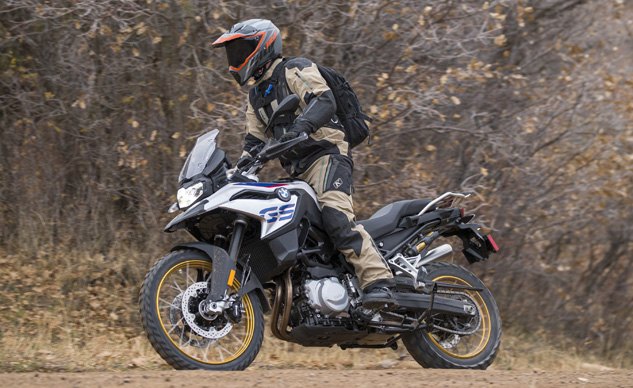
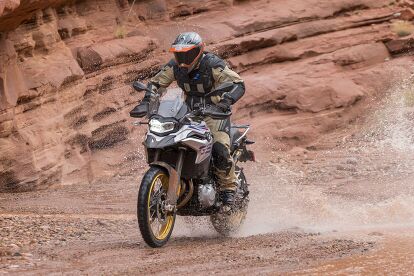





































































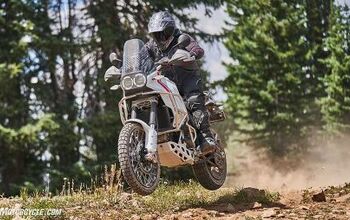

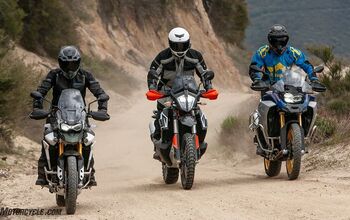
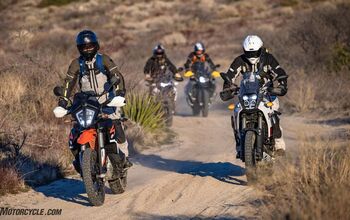














Comments
Join the conversation
It will be interesting what the tire manufactures come up with for these bikes in the next year or two. A bike is only as good as it's tires.
As strongly as I believe that real 'Adventure' motorcycles need to lose both displacement and mass to be usable in off road conditions, these simply are not those bikes.
The mass on these bikes is within spittin' distance of a R1200GS -- the R12 is @ 560 wet and these are @ 510. Still too heavy for any truly 'gnarly' stuff.
And how you could provide all this information without mentioning that these engines have been outsourced by BMW to a Chinese manufacturer - Loncin - without any improvement in their pricing relative to market is a pretty significant oversight. Some of the first bikes shipped to other markets needed to be recalled when it was discovered that the oil pump drive, well, didn't.
I could maybe put up with Heavy and Expensive when the motors were bulletproof.
This? Not so much.